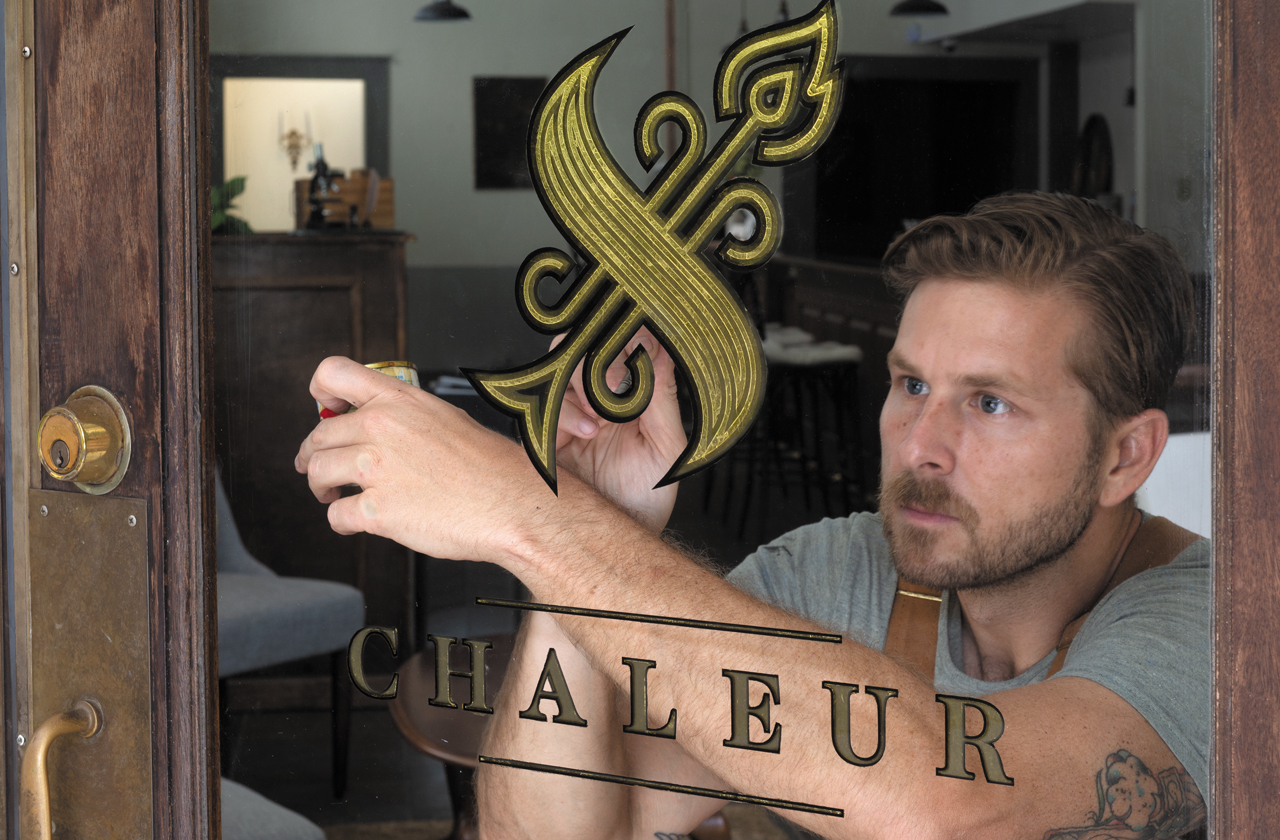
Andy Scott paints signs and does traditional gold leaf gilding under the moniker New Hand Signs — a play on the fact that he’s a new hand at the once ubiquitous profession. Scott seems well-suited to nostalgic pursuits. He works out of a well-cared-for 1964 Ford van. His speech is liberally spiced with terms like “neat” and “cool.” He works to 1960s and ’70s music, although it emanates from an iPhone, not 8-track tapes. But his serendipitous connection to sign painting dates back only a couple of years.
When Chase Scott stumbled across a 1960s painter’s box, he thought it might interest his artistically inclined older brother, Andy. His gift sparked far more than mere interest.
“It’s just so cool,” enthuses Andy, who talks about Hollywood, California, sign painter Don Souder (the box’s original owner) like a long-lost friend and mentor. “That box definitely took me down a path. I dug into it, trying to figure out all of the tools he used and to learn everything I could about him.” Laughing, he admits to being “a little obsessed.”
Obsessed? A thrift store copy of Edward J. Duvall’s 1952 classic, “Modern Sign Painting,” became his most-read book. “It shows how to do so much: how to hold your hand, how to do the brush strokes. I started with these casual letters right here,” he continues, book in hand. “For six or seven months, I would sit at the kitchen table every night and draw lines, do ABCs. It’s crazy how long it took to get those strokes down.”
Once comfortable with casual, Scott proceeded to block letters and script. “From there you can go on to serif and sans serif and eventually create your own style. It’s never-ending,” he says.
He’s not exactly starting from scratch. Scott briefly worked for a mechanized sign company before entering the University of South Alabama, where he earned a graphic design degree. As a student, he launched (and eventually sold) his own vinyl sign shop. That previous experience and collegiate coursework provided skill sets transferable to his new endeavor, although little of it influences the art itself.
“It comes into play mostly in design. I can walk in, look at the space and tell them what works in there,” he says. “It also comes in handy when I’m designing logos and laying out signs. Plus, I know how to design large scale. I work comfortably, even when it’s really big.”

For Scott’s generation of aficionados, sign painting can be a solitary pursuit. Older sign painters who’ve managed to stay relevant occasionally gather at Letterhead meets, where they share ideas, tips and techniques. A more seasoned recent convert, Aaron Taylor with Pensacola’s Brix Design, instructed Scott in gold leaf gilding. But, for the most part, he picks up technique from studying old signs and reading old books.
“There’s only one school for sign painters, the Los Angeles Trade Technical College,” he laments.
It wasn’t always like that. In 1982, Scott was born into a world where virtually all signs and billboards were painted. The largely unionized profession maintained strict aesthetic standards. A national network of specialized trade schools and demanding apprenticeships spewed skilled artisans whose elegant, perfectly aligned and spaced lettering was painted freehand, not stenciled. But ’82 also witnessed the birth of computer-controlled vinyl plotters — machines that quickly mechanized the industry. Professional sign painting jobs evaporated.
Sign painting’s current resurgence (like those of film photography and vinyl records) still leaves it a tiny, specialized niche within the industry it once ruled. New Hand Signs rapidly grew into a profitable sideline. But it won’t be replacing Scott’s day job anytime soon.
“I kind of pick and choose the projects I do because it’s not a full-time gig,” he says.
He enjoys variety. Work for El Papi Mexican restaurant included designing a company logo, gold leaf gilding on the front door, plus interior and exterior signage. Delchamps Printing, by contrast, hired him to paint over someone else’s letters.
Delchamps wanted old, faded-out signs to be legible without sacrificing the character that weather and age had given them. “When old signs fade out like that, you can see every single brush stroke, how everything was done. I could see the type of brush the guy had used,” Scott explains enthusiastically. “It turned out pretty cool. It was like breathing life back into something that someone did a long time ago.”





